HACK ATTACK
‘Clearing Table Mountain one alien plant at a time’ — dedicated teams root out invasive flora
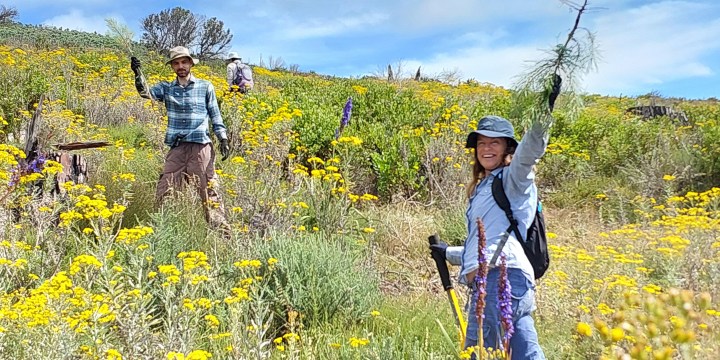
Every week, volunteer hackers are clearing the Cape Peninsula mountains of invasive alien plants so the rest of us can enjoy pristine fynbos and forest.
“Join the hack today. Jeep Track leading to the Secret Garden. Bring popper, loppers, gloves, pliers and garden fork if you can.”
Each week, calls like this appear on WhatsApp chats all over the Cape Peninsula.
Having nothing but pliers and unsure what a popper might be, I join a small team on the slopes of Table Mountain one Sunday afternoon. It turns out poppers are long yellow handles attached to jaws with which you lever out mostly Australian invader plants, of which there seem to be thousands.
Janet Small is using one to haul out Port Jackson, watched by her two patient dogs. She tosses each one over her shoulder and moves slowly uphill. “You have to get them early or they’re hard to get out,” she says.
Dawie Bosch, with his large friendly poodle, is addressing just such a problem. “See here,” he says, his leathery smile lines testament to years in the sun tracking down aliens, “poor alien clearing. They cut and didn’t poison properly, so the tree coppiced — sent outside shoots and kept deepening its roots. Now it’s really hard to get out.”
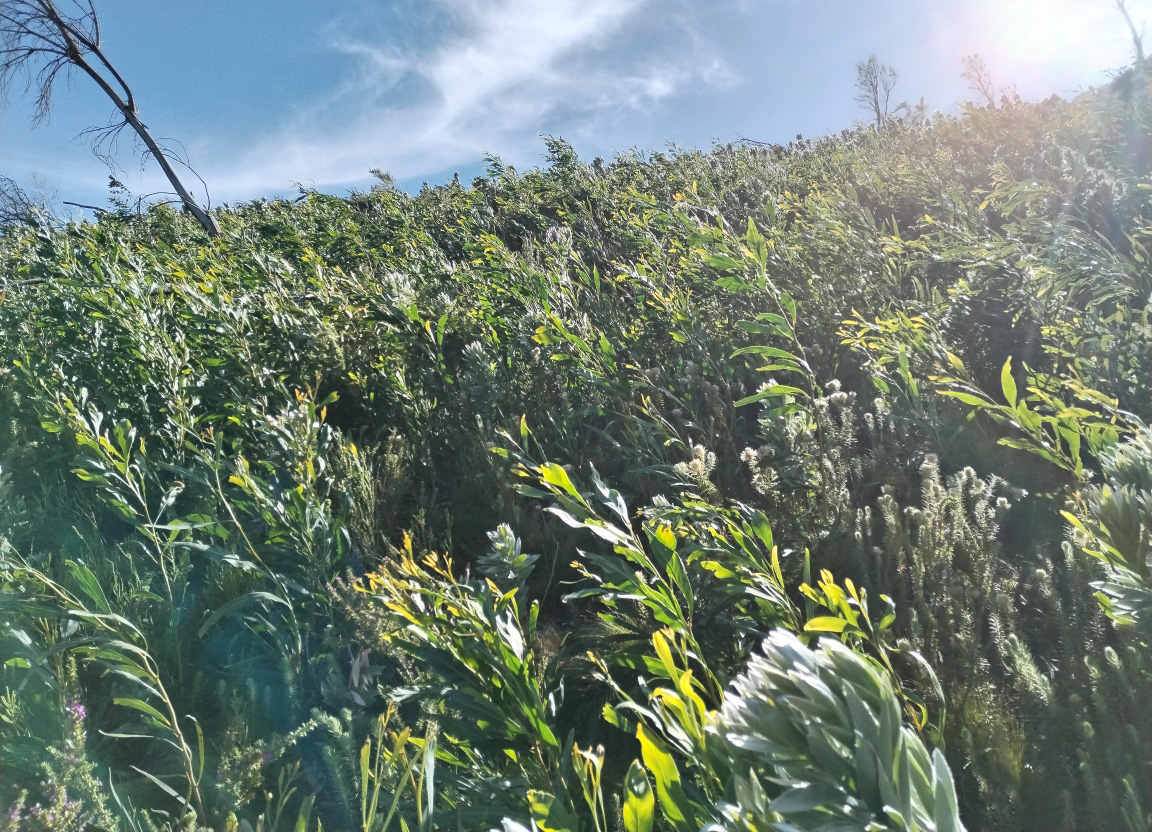
Port Jackson infestation before clearing. (Photo: Supplied)
He digs around it with gloved hands to get a grip lower down, engages the popper and puts his weight on the yellow handle. Slowly the root yields and finally rips loose. Dawie holds it up triumphantly.
“This,” he pronounces, “gives me pleasure. We’re clearing Table Mountain one alien at a time. But they keep coming back, of course. Eighteen months after a botched clearing exercise by a Table Mountain National Park contractor, the area ended up with so much alien it took us six months to clear 20m².”
I look at the slope covered by Port Jackson treelets and wonder at the dedication of hackers who do this sort of thing voluntarily week after week, year after year. I want to know who they are and what motivates them because, as guardians of the Peninsula’s magical mountains, they’re unsung heroes.
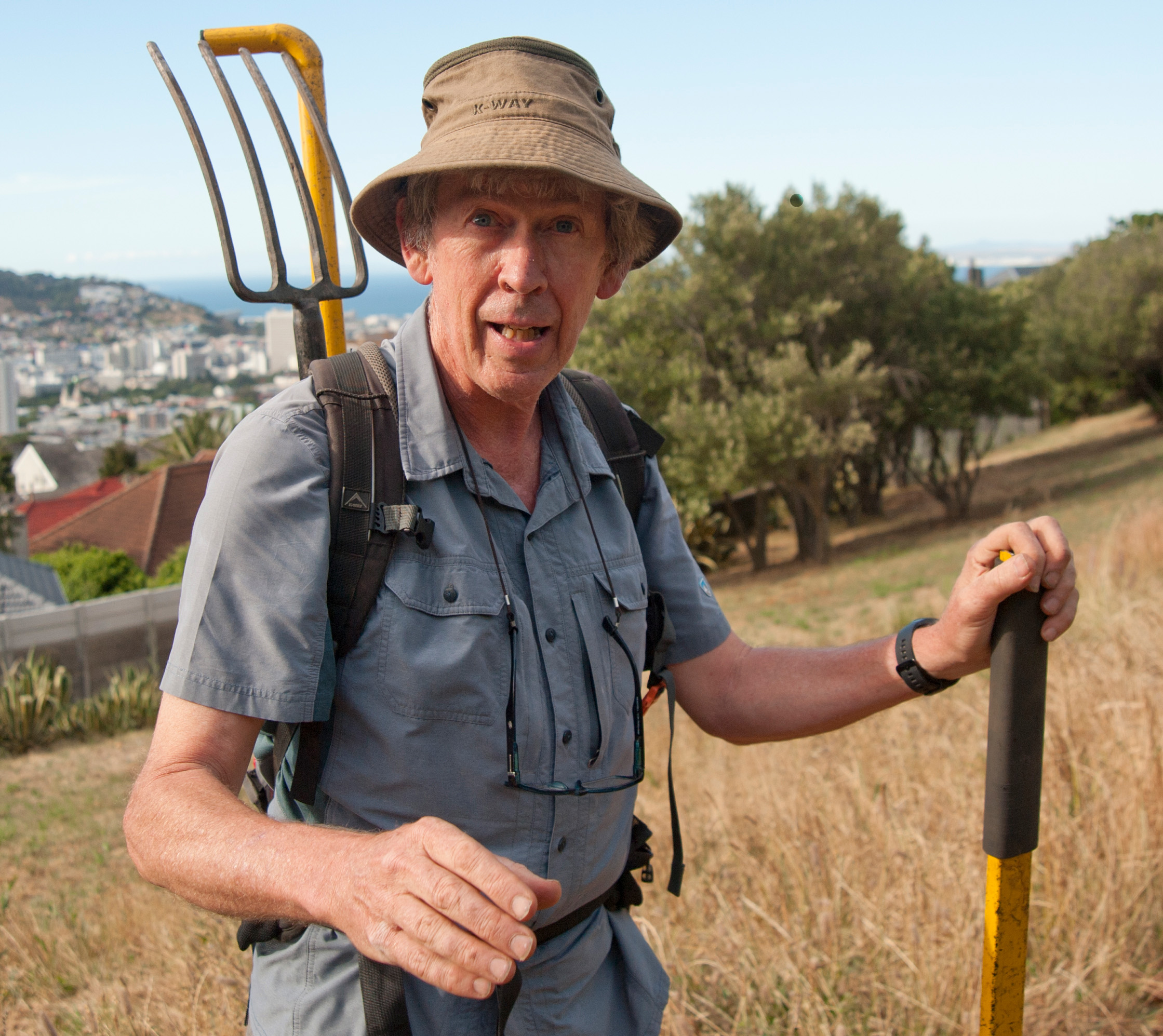
Volunteer hacker Dawie Bosch. (Photo: Don Pinnock)
A good person to ask, it turns out, is Sandy van Hoogstraten. “It’s an addiction,” she says. “The Cape Floral Kingdom is … priceless. Of the world’s six floral kingdoms, it’s the smallest, the most diverse and the only one contained in a single country.
“The problem is that only 1% of lowland fynbos is conserved. It’s being swallowed by farms and highways. Fynbos is vanishing. But the greatest threat to it now — lowland or mountain — is alien vegetation.
“It’s like climate change. For a long time, the problem grows slowly and nobody does enough about it. Then, by the time you realise it’s a serious problem, it’s too late. Hockey-stick graph. We’re pretty much there.”
According to Unesco, Cape fynbos represents less than 0.5% of the area in Africa but hosts a fifth (20%) of the continent’s flora. There are about 9,000 plant species, of which 1,736 are threatened and 3,087 are of conservation concern.
“You drive around the Western Cape and what do you see? Black wattle, pine, hakea, Port Jackson, wheat. Monoculture. It’s like … a green wasteland. But it’s not dead. Those trees are having babies, spreading.”
Hackers, she says, are into biodiversity conservation. They love fynbos. Invasive alien plants steal water, change soil structure, cause erosion and rip up the fabric that makes fynbos so special. When they burn they burn hotter, posing a fire hazard and damaging the natural ecosystem. But for Van Hoogstraten there’s an additional reason to hack: job creation.
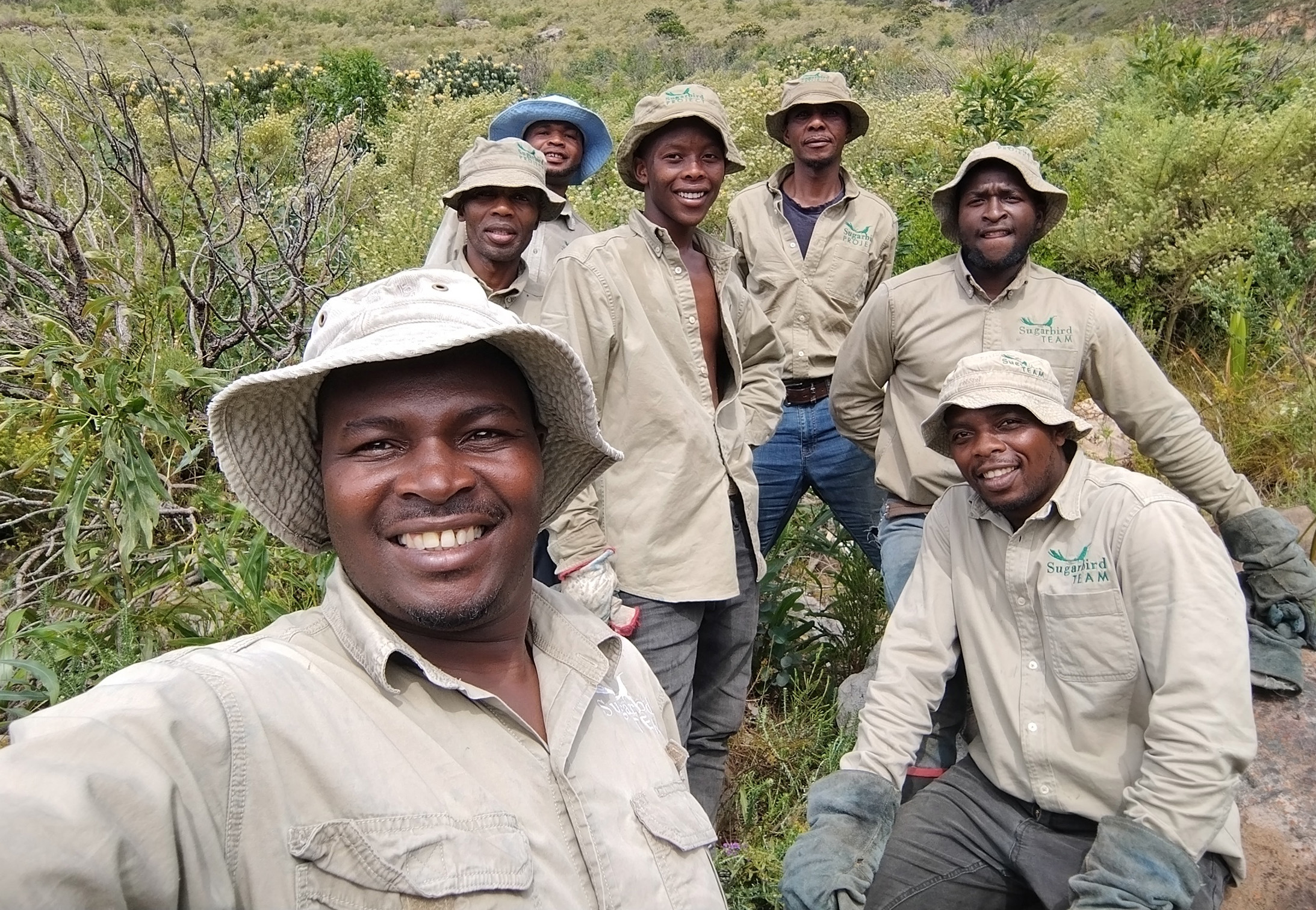
Sugarbird leader Glen Mabekha (front left) with his team of full-time hackers who clear invasive alien vegetation. (Photo: Supplied)
“In 2010, I was complaining to my husband about the Port Jackson invasion on the slopes behind Camps Bay and he said: ‘Why don’t you do something about it?’ So I paid for one guy to start hacking it, then another guy, and soon I had a team of four. A few years later I started a second team at Chapman’s Peak.
“After a fire on Lion’s Head in 2020, the Port Jackson came up like hair on a dog’s back, so my team cleared it. Maya Naumann, who was hacking with a community group on Signal Hill, noticed their great work and contacted me. We teamed up and started the Sugarbird Project. Why Sugarbird? Because sugarbirds are endemic to fynbos. When the sugarbirds come back, you know the fynbos is thriving.”
They raised money to pay teams to work full-time and the project grew. Two years in, there were seven teams with 39 men in all, working in areas such as Signal Hill, Lion’s Head, Camps Bay, Devil’s Peak, Rhodes Memorial, Newlands Forest and Hout Bay.
“We have a good relationship with SANParks, who also hire contractors to do hacking under the Working for Water initiative.”
It is, she says, a labour of love. You see a section of Table Mountain that’s almost destroyed, you bring in a team to clear, and in a season that area is pristine and beautiful.
“People will pay a million rand for a picture on their wall. But you give six men a job for a month and you end up with something far more beautiful than a picture on the wall and something everyone can enjoy.”
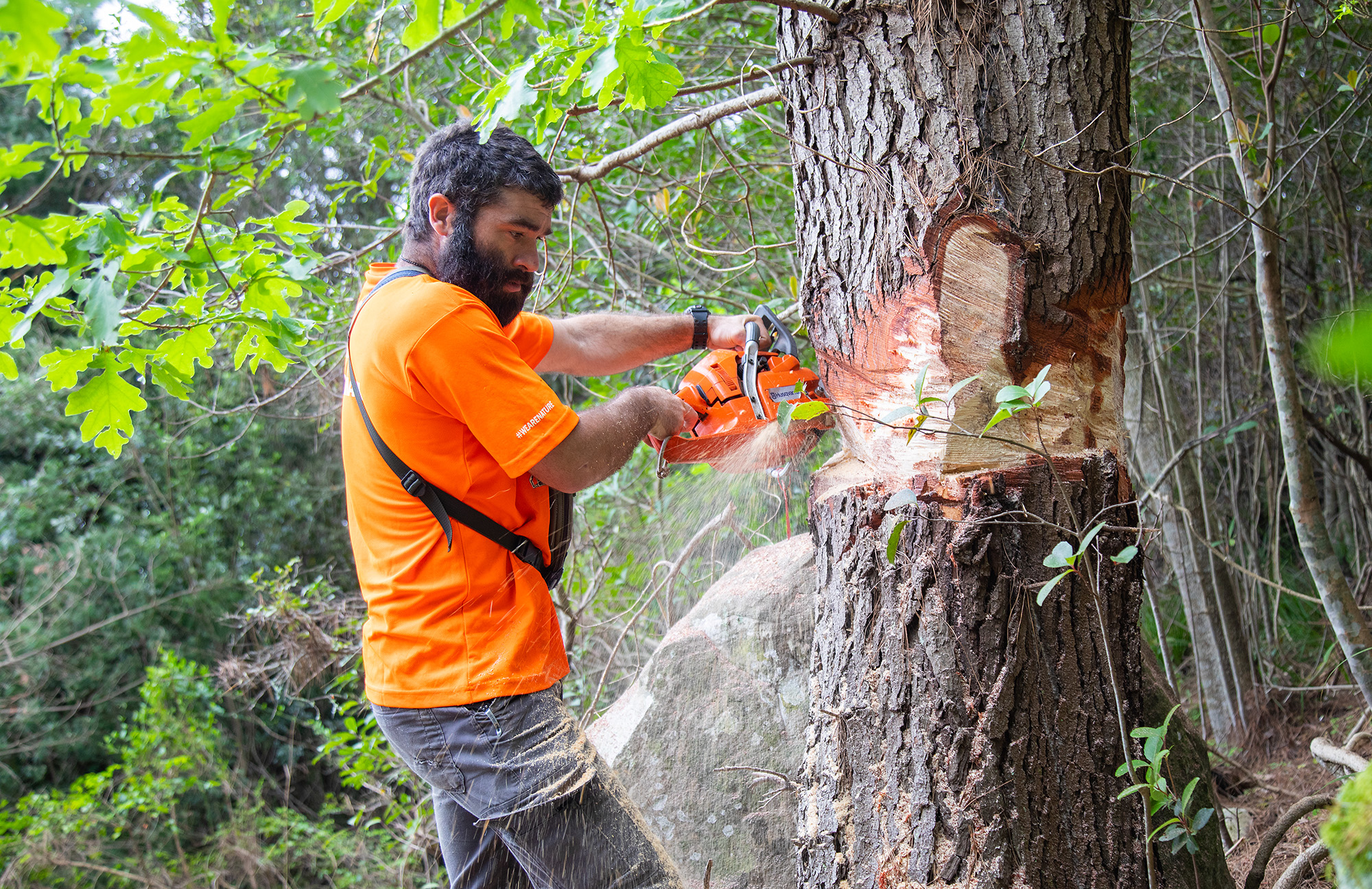
It’s a tough job but someone’s got to do it. (Photo: Supplied)
The whole project is run on WhatsApp. Each morning a team takes a picture of themselves and the area they’re about to clear, then a picture of the cleared area at the end of the day.
“The teams are contracted, so we’re supporting entrepreneurship. We who organise it are volunteers. Donors love the model. Basically, it’s a transfer of 100% of the funds from the rich to the poor, with biodiversity conservation as the outcome. No overheads and the money goes directly to the community. The teams are fully supported, with training, uniforms and good equipment. Next year, we’re hoping to expand to 12 contracted teams with 60 men in all.”
Table Mountain National Park consists of about 25,000ha and SANParks has mapped it into about 1,000 units. Working for Water employs women to clear aliens in these units but their pay is low and, it has been alleged, their enthusiasm matches their pay packet.
Sugarbird pays well and, according to Van Hoogstraten, this builds enthusiasm, pride and interest in the work. SANParks reciprocates, providing herbicide, permits and planning to do the clearing work effectively.
Part of the Sugarbird system is to link paid hackers with local community hackers who are generally highly skilled and knowledgeable people who hack for the love of it.
There’s even a Helihack team that uses a chopper to get to inaccessible places. They’re dropped in, armed with chainsaws, and have removed thousands of pines from inaccessible places, risking their lives against invaders.
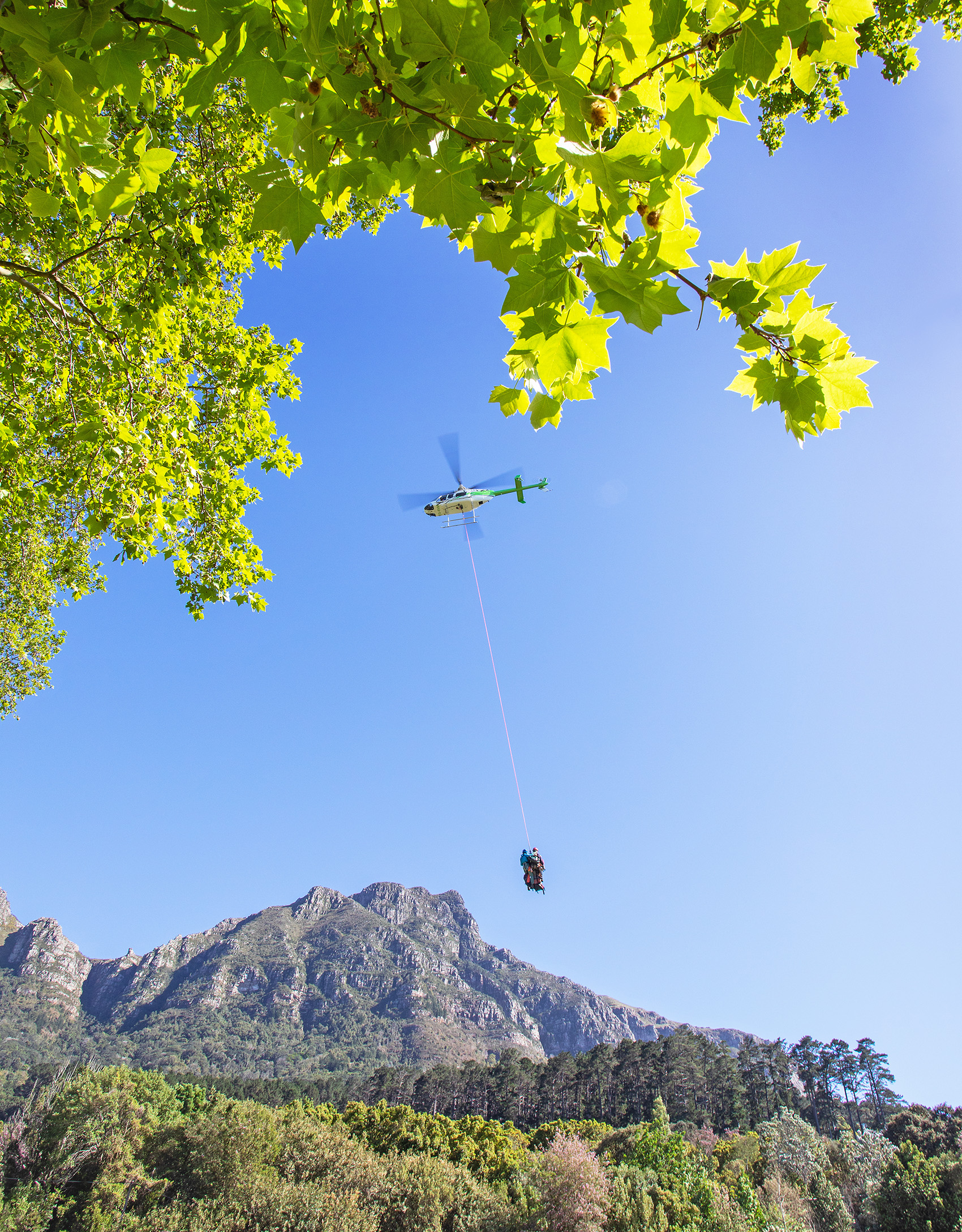
Helihackers are used to root out alien vegetation in inaccessible places. (Photo: Supplied)
Hackers include a wide range of people who hack as a labour of love. They give oversight, do follow-ups and offer encouragement to the paid guys for work well done.
One of those volunteers is Liz Sparg, who started the Rhodes Memorial/Newlands Forest hacking group in 2020. She noticed the pine trees growing in the forest and got a permit from SANParks to start clearing the area above the old zoo. She met Maya Naumann when volunteering at a hack on Lion’s Head and over time started working closely with the Sugarbird Project.
Another passionate volunteer is Anton Weers, who works in cloud computing and has been a hacker on and off for more than 20 years. When people want plants identified, he’s the man.
“They’re mostly Australian,” he says. “The climates are similar, but over there natural enemies inhibit their growth and reproduction. Here nothing stops them.
“Pines and gums were imported and grown in plantations for wood and paper production. Pine seeds are then blown high into the mountains, allowing them to spread rapidly. Gums were often used as firebreaks in addition to forestry.”
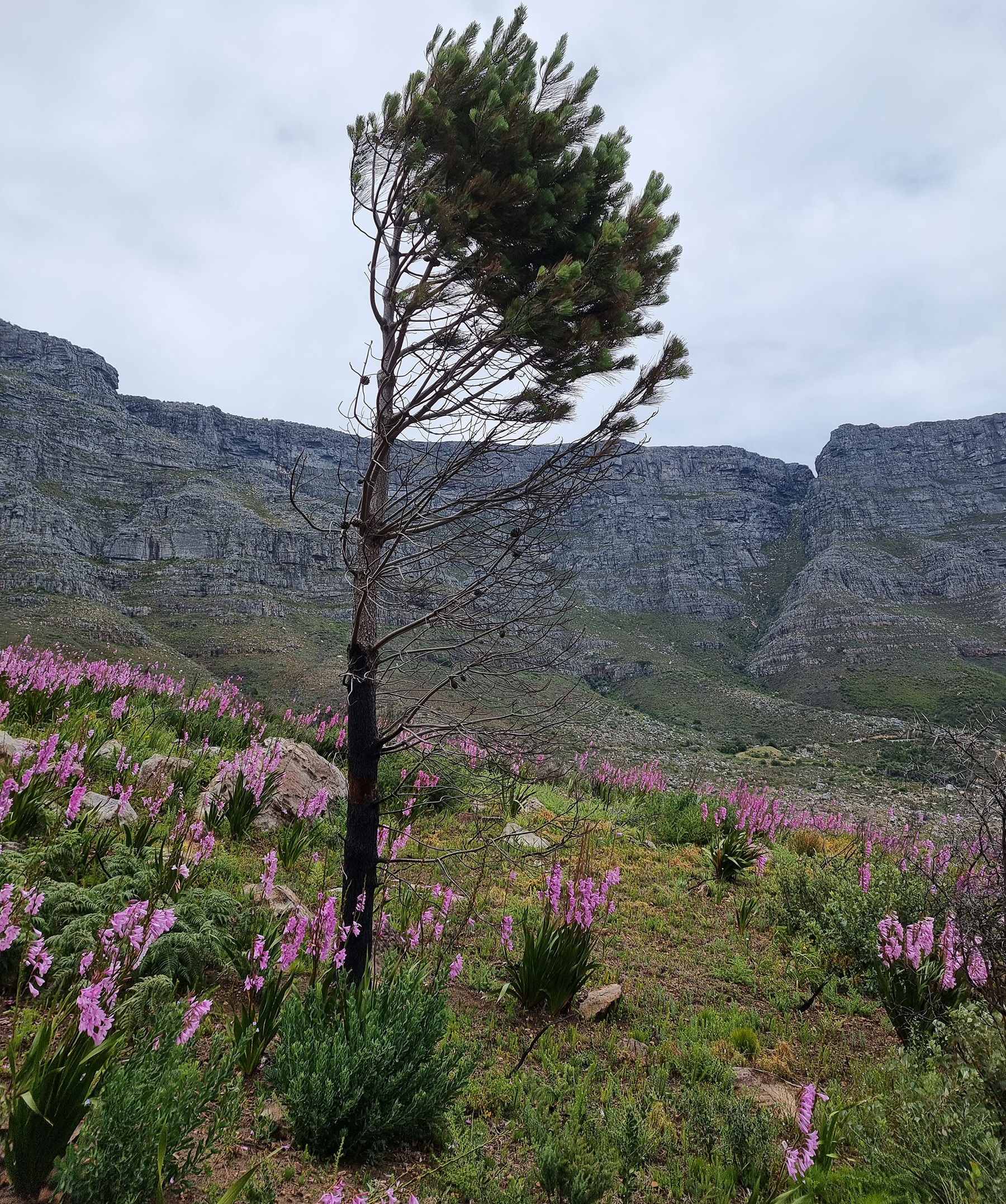
Pinus pinaster (cluster pine) in a field of pink watsonias on the mountain. (Photo: Anton Weers)
Read more in Daily Maverick: Creecy launches R2.6-billion invasive species programme — experts say more funding needed in critical areas
Port Jackson and rooikrans were planted on the Cape Flats to stabilise the sand. Bottlebrush — also Australian — are used as ornamental plants but often escape captivity and find the local conditions favourable.
Seeds like Port Jackson lie dormant when under other cover, but when there’s a fire that cover goes and the heat and smoke stimulate germination. The germination cues that stimulate fynbos seeds to germinate also work on the Australian acacias.
“I guess it’s a hobby,” says Weers reflectively, “but also it’s so stimulating personally when you come back to an area and it’s clear of aliens and pristine again.”
Van Hoogstraten agrees. “After the [University of Cape Town] fire, Port Jackson took over and it was a horror show. But the Rhodes Memorial team cleared it and now there are thousands of silver trees interspersed with pink watsonias. I cannot tell you what that feels like — it’s transformation on another level! You just can’t put a price on saving the Cape Floral Kingdom.” DM
This story first appeared in our weekly Daily Maverick 168 newspaper, which is available countrywide for R29.






















 Become an Insider
Become an Insider
SANPARKS is supposed to do the alien invasive species clearing but they don’t do their work. Just as in Wilderness park. Its a total mess.
Congratulations to all those individuals who have dedicated their time and energy clearing the unrelenting onslaught of alien plants that destroy our indigenous species. I for one am highly appreciative of your efforts organizing teams of paid workers and volunteers. A very happy and prosperous New Year to you all.
Indigenous good, alien bad: an easy, simple-minded formula. Has Sugarbird considered the cultural landscape? It’s not true that stone pines, flowering gums and oaks, among others, were planted for purely industrial reasons. They improve the quality of life by giving shade, and cleaner air. Some trees need management, not destruction. By all means take out the Port Jackson on the mountain slopes, but be discerning. There’s an environmental justice argument here too: there are countries that use a ‘tree equity index’ to measure the quality of life: globally, poorer neighbourhoods are hotter and have poorer air quality, for the absence of trees. We all love fynbos but fynbos fundamentalism is driving some unnecessary destruction.
There are MANY indigenous species of trees than can be planted and nurtured for the benefit of human beings – exotic species that have the ability to spread unchecked I believe have no place in propagation or being planted in SA, unless under licence from the relevant departments for silviculture purposes.
I don’t think the Sugarbird narrative mentioned removing flowering gums, stone pines and oaks from their early domestic or commercial locations. Its clearly focused primarily on port-jackson (and, I presume, hakea) and pine, gum and wattle plantation escapees (seedlings growing wild outside gardens and commercial plantations). One only has to drive from Somerset West to Bot River and through large stretches of the garden route to see those escapees working their way up the mountainsides (and across the lowlands) and obliterating the fynbos and its wonderful textures and colours. I don’t disagree that there are some unfortunate fundamentalists who overdo the no-exotics bit, but it seems to me that to criticise the Sugarbird crew is to miss the point (I have no connection whatever to Sugarbird by the way, or to National Parks).
There are examples of indigenous trees having been planted in areas – notably along the edge of what is left of the Tokai forest – where they fail to thrive. An treed cultural landscape typically produces a canopy, which is hard to achieve if fynbos is planted exclusively. Unfortunately the destruction is not only concentrated on escapees – that would be acceptable – because we are seeing areas of the urban forest being targeted.
‘a treed cultural landscape’. If Sugarbird’s work is confined to the TMNP, well and good. The problem is that the article doesn’t register the other side of the debate, or the fact that the trees on our urban edge are disappearing with ever increasing speed. See the work of Parkscape (which has worked with Sugarbird) whose role is to address the problem.
One of the biggest causes of invasive infestation in TMNP is the 2005 exit from plantation forestry and the failure by SANParks to manage the land. It’s worth noting that per the founding intent of the park, plantation forestry was supposed to continue – as part of the WHS – given the role of the plantations in the cultural landscape of Cape Town, and the shaded recreational value provided, especially to those from previously disadvantaged communities.
While the effort to restore fynbos is unquestionably correct – as is getting rid of swathes of port jackson, black wattle etc. – hacking without removing the resultant slash creates fuel loads, which result in more and hotter fires, and this results in more invasives – while these very hot fires risk destroying whatever fynbos seedbanks may exist (the soil issues of heathlands/fynbos and urban nutrient content and environmental changes aside).
The problem of invasives impacts not just on Table Mountain but is a problem across the Western Cape where the forestry exit strategy was pushed through. (Again, it’s worth noting that in many places the exit has been and is being reversed because of the environmental damage and timber shortages).
In the Cape Town context, the impact of the forestry exit, as David Attwell has noted, has resulted in not only the loss of cultural and heritage landscapes but also of vast tracts of Cape Town’s managed urban forest that would have helped mitigate increasing urban heat island effects.
Great to hear that the full benefit of the funding goes directly to those doing the work, not like tax money that is mostly allocated to “those that need to eat a little bit”, leaving a pittance, if anything, for the job itself. Keep up the good work!
“Aliens” and their management always create vexatious commentary. For me they have a definite place in the urban environment where benefits are enormous. Outside of the urban area there needs to be a different focus, that needs reconsideration now in 2024. Removal needs to be specifically targeted and focused or problems c may and do arise. Right now South Africans are polarized and this is unhealthy.